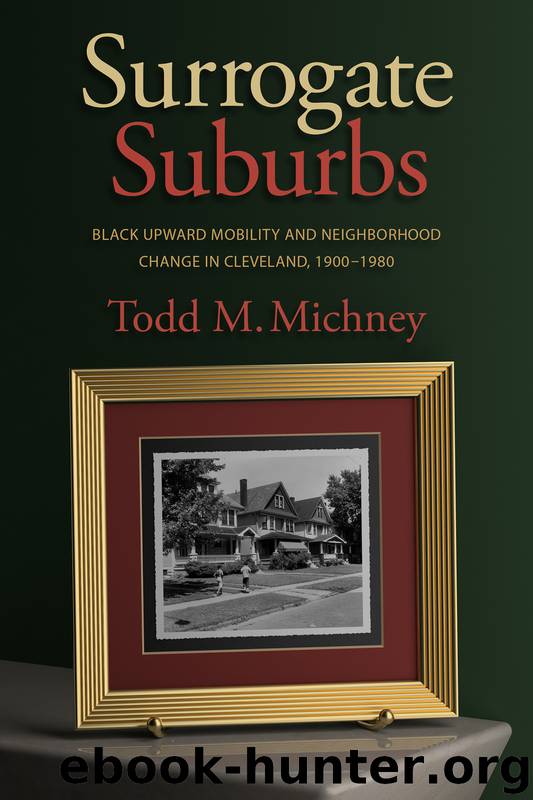Surrogate Suburbs by Todd M. Michney

Author:Todd M. Michney
Language: eng
Format: epub
Publisher: The University of North Carolina Press
Published: 2017-03-07T16:00:00+00:00
Corlett
Located immediately south of Mount Pleasant and spanning Harvard Avenue approximately from East 116th Street to 154th Street, Corlett is best understood as a second-tier neighborhood to which many individuals moved from more cohesive ethnic communities. Not annexed to the city until 1909, land development here resembled patterns in both adjacent Mount Pleasant and Lee-Harvard. The bulk of Corlett, west of East 140th Street, was developed during the 1920s with a mixture of double-and single-family homes. In contrast, the neighborhood’s eastern portion—particularly beyond East 147th Street—still contained considerable vacant land in 1940 and was built up with numerous single-family, ranch and colonial-style homes, much as adjacent Lee-Harvard had been. Between 1950 and 1960, in fact, there was still housing under construction, with 444 units built in the neighborhood’s easternmost census tract alone, some 30 percent of the 1960 total.73 The predominant ethnic groups in Corlett were Czech and Polish, many of them having moved out of their nearby, older Broadway Avenue settlements into the neighborhood by 1950; smaller numbers of Italians also lived in the area.74
Small numbers of African Americans also lived in Corlett from early on. In 1940, twenty-four black families were sprinkled through the blocks north of Harvard Avenue and west of East 140th Street, and they apparently coexisted peacefully with their white neighbors. One such African American family that Julian Krawcheck interviewed in 1956 had been living at 13507 Crennell Avenue since 1917, tipped off to the destination by a black plasterer friend who had done work in the area. This family had been directed by the Guardian Savings & Trust Co., one of Cleveland’s most prominent turn-of-the century banks, to a “sub-rosa,” subsidiary mortgage company for financing. By 1956, the street had about a dozen additional African American households, but the immediate area was described by the original black family as “90% white” and having the “very finest [race] relations.” Home values had steadily risen, and new black residents maintained their properties admirably. Incidentally, other researchers have documented this pattern of “isolated” African American families being accepted by their white neighbors in other Northern cities.75
Due to its mixed housing stock and population, Corlett was described by the early 1960s as “actually two communities,” with disproportionately elderly white ethnic residents predominating in the mix of older, one-and two-family houses in the neighborhood’s western portion, and upwardly mobile black families in the newer, single family houses in the eastern section bordering Lee-Harvard. The Cleveland Press reported, “Negroes first moved into the E. 147th St. area before 1950 and spread south to the [newer] Judson Dr. area,” and, indeed, the relevant census tract went from 0.4 percent black in 1950 to 24 percent in 1960, indicating a rapid racial transition with spillover from the Kinsman Heights enclave in Mount Pleasant. One Italian former resident, whose family moved onto East 147th Street in 1942, estimated the street had been 5 percent black at that time. His family remained until 1957 and claimed that interracial relations were neighborly but not intimate;
Download
This site does not store any files on its server. We only index and link to content provided by other sites. Please contact the content providers to delete copyright contents if any and email us, we'll remove relevant links or contents immediately.
| African-American Studies | Asian American Studies |
| Disabled | Ethnic Studies |
| Hispanic American Studies | LGBT |
| Minority Studies | Native American Studies |
Cecilia; Or, Memoirs of an Heiress — Volume 1 by Fanny Burney(32491)
Cecilia; Or, Memoirs of an Heiress — Volume 2 by Fanny Burney(31909)
Cecilia; Or, Memoirs of an Heiress — Volume 3 by Fanny Burney(31887)
The Great Music City by Andrea Baker(31754)
We're Going to Need More Wine by Gabrielle Union(19001)
All the Missing Girls by Megan Miranda(15765)
Pimp by Iceberg Slim(14433)
Bombshells: Glamour Girls of a Lifetime by Sullivan Steve(14019)
For the Love of Europe by Rick Steves(13505)
Talking to Strangers by Malcolm Gladwell(13284)
Norse Mythology by Gaiman Neil(13271)
Fifty Shades Freed by E L James(13185)
Mindhunter: Inside the FBI's Elite Serial Crime Unit by John E. Douglas & Mark Olshaker(9259)
Crazy Rich Asians by Kevin Kwan(9216)
The Lost Art of Listening by Michael P. Nichols(7452)
Enlightenment Now: The Case for Reason, Science, Humanism, and Progress by Steven Pinker(7271)
The Four Agreements by Don Miguel Ruiz(6696)
Bad Blood by John Carreyrou(6581)
Weapons of Math Destruction by Cathy O'Neil(6206)
